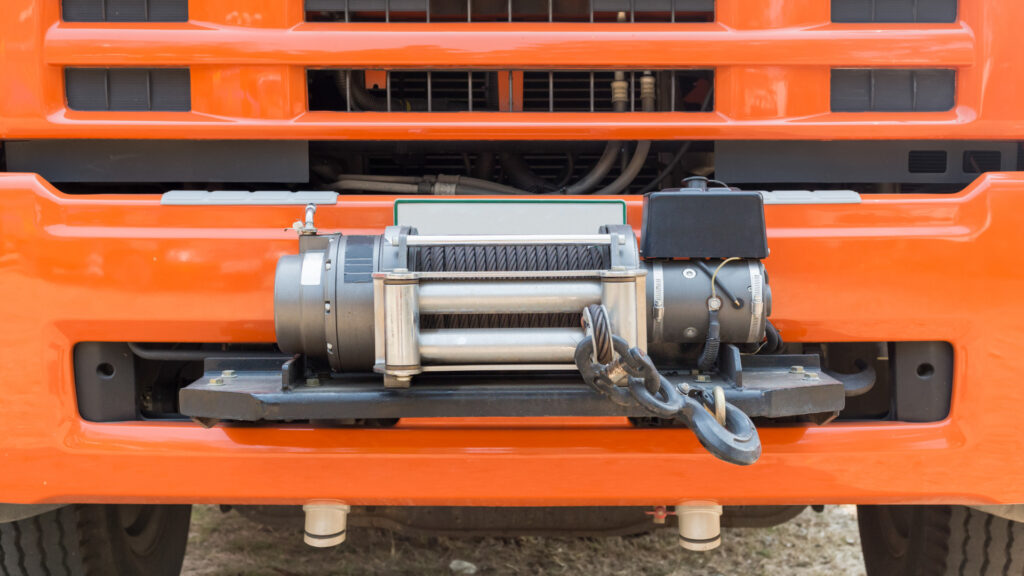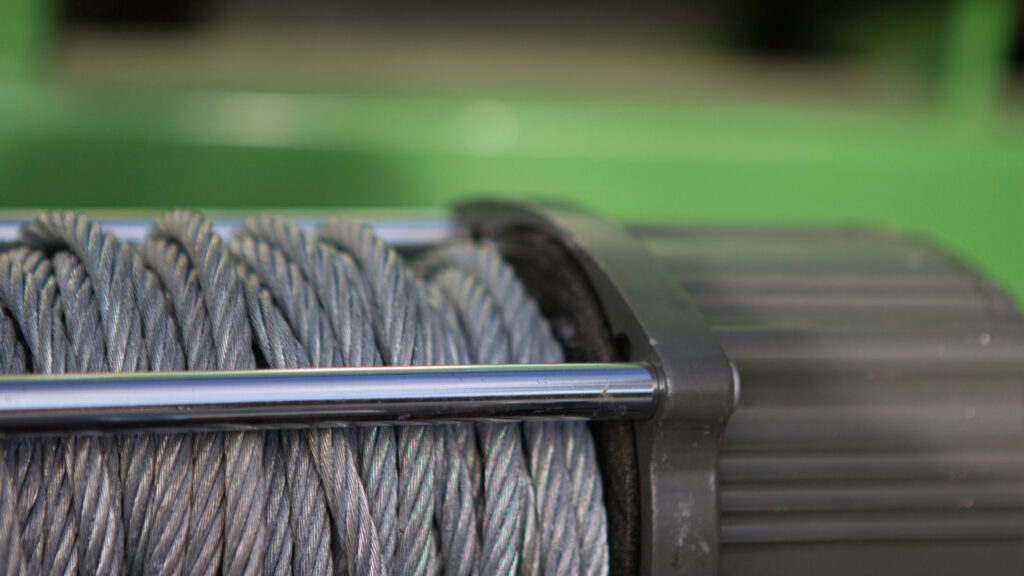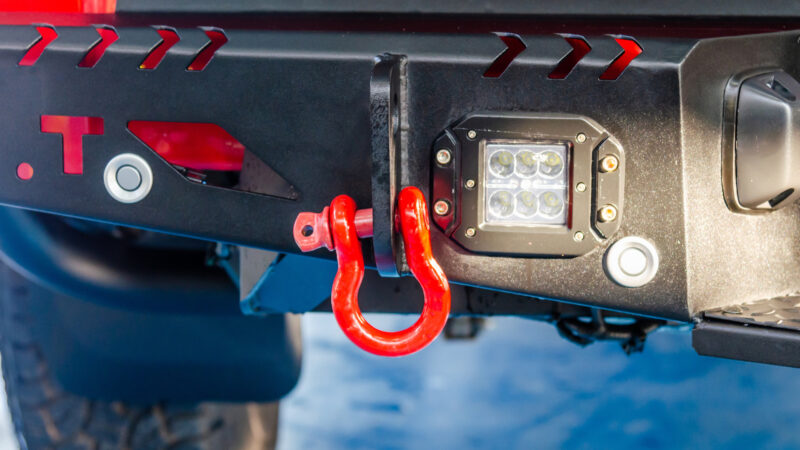Table of Contents Show
Off-road adventures can be exciting. However, if you’re not careful, truck winching can make it exciting for all the wrong reasons. The proper skills and knowledge can increase safety for you, those with you, and any vehicles involved.
We want to help you avoid making a bad situation worse. That’s why we’ve created our truck winching dos and don’ts list.
Buckle up, and let’s get started!
What Is Truck Winching?
A truck winch is a mechanical device that drivers mount to the front or rear of off-roading vehicles. They can assist with pulling and recovering vehicles, especially in challenging terrain. You want a recovery system if you push your vehicle’s capabilities to the max.
The equipment uses strong cable or synthetic rope, a cranking mechanism, and various gears and pulleys. One cable end attaches to an anchor, typically a tree, rock, or vehicle. The tension helps exert force to recover a stuck vehicle.
Why Do You Need a Winch on Your Truck?
Having a winch can be helpful in many situations. Losing traction in terrains littered with mud, sand, and snow is common. You may rely on someone else to rescue you in the worst cases. However, if you have a winch on your truck, you can get yourself out.
Additionally, these pieces of equipment can assist with navigating difficult situations, particularly steep inclines and declines. The device’s cable or rope can help absorb the load and pull the vehicle in the proper direction. Truck winching helps prevent rolling and tipping over in extreme situations.

How Does Truck Winching Work?
A truck winch uses external anchors to force a vehicle in a particular direction. The tool and its powerful motor slowly increase the tension of the cable or rope between the anchor point and the car.
It increases the force, helps control weight distribution, and prevents sudden shifting. The added support can increase your safety, whether navigating a steep incline or getting out of unpacked sand.
However, the process requires knowledge and skill. If done correctly, you can protect your equipment. Additionally, if you don’t know what you’re doing, it could lead to severe injuries. Always take the proper safety precautions when using a winch.
Truck Winching Dos
You need to do certain things any time you use a truck winch. If not, things may go differently than planned. Let’s learn more.
Know Your Equipment
It may seem common sense, but many people buy and install the wrong equipment on their vehicles.
You need to know the capabilities and limitations of your specific equipment. This can help ensure you don’t overstress anything. If it fails in the middle of using it, it can cause a hazardous situation.
Read the specs and ratings for your winch. It’s often better to err on the side of caution and get the most capable device. Always take safety seriously in these types of situations.
Use Proper Gear
Truck winching requires a lot of equipment, such as snatch blocks, tree straps, shackles, and various other accessories. Knowing what to use and when is essential.
This is why we mentioned that this task requires much knowledge and skill. If you don’t know what you’re doing, it’s best to leave it to a professional.
In addition to gear for your vehicle, it’s also important to remember your safety gear. A solid pair of gloves will go a long way to keep your fingers safe. Remember to protect your eyes and wear sturdy shoes. If your truck gets stuck, likely the terrain will be less than ideal for your feet as well.
Assess the Situation
One of the first things you should do when using a truck winch is to assess the situation. You should look for potential safety issues for yourself or anyone around the area. Take your time to evaluate the entire situation to take the proper precautions.
After assessing the situation, it’s time to devise a plan. Look for anchor points, consider the various techniques, and estimate how much force you’ll need to use. Once you have a plan, communicate that with anyone involved in the situation. Everyone needs to be on the same page to be successful.
Use Ground Anchors
Ground anchors help improve the stability and effectiveness while truck winching. They can increase the amount of resistance and offer more pulling power.
These anchors are incredibly effective in areas where with few trees or rocks. You can place the anchors exactly where you need them.
A benefit of ground anchors is the reduction in impact on the environment. You don’t have to worry about causing damage to trees and other natural features. If you want to handle anything, a ground anchor is a good place to start.
Keep Tension on the Cable
A winch only works when you keep tension on the cable. The second you release the tension, it no longer supports the vehicle. If your truck is in a compromising position, this could result in rolling or severe damage.
It could also result in serious injuries depending on where people stand. Always communicate with spotters and anyone lending a hand when releasing the tension.

Truck Winching Don’ts
Now let’s discuss the don’ts of truck winching, from safety to damage. You could find yourself in quite a predicament if you ignore certain tips.
Exceed the Weight Limit
Trust us; you don’t want to learn this the hard way. Always stay within the weight limit for your equipment. You can strain the motor, gears, and other equipment.
In addition, you reduce the effectiveness of your equipment. It may do the job but will likely struggle and take longer.
Always check your gear and equipment regularly. Immediately address any damaged parts or indications of issues. This can help you avoid putting yourself, others, and your vehicle in danger.
Pro Tip: You never want to exceed the weight limit for your RV! Before you hit the road, see How to Weigh Your RV at a CAT Scale
Use Inappropriate Anchor Points
When choosing your anchor points for truck winching, know if they can handle the job. If the anchor point fails, it can easily result in an accident, injuries, and damage to your truck. Insufficient anchor points can result in an ineffective recovery, and you’ll be stuck.
Don’t overlook the fact that using inappropriate anchor points can cause damage to the environment. We’re big fans of nature and the outdoors. We encourage everyone to take care of the land so all can enjoy it.
Using anchor points can negatively impact the natural environment, primarily when incorrectly used. Investing in protective mats can help avoid causing unnecessary damage to trees and other objects.
Stand Close to the Cable
One of the worst things you can do is stand too close to the cable. This is a significant safety hazard you should avoid.
While the line may be strong, it’s not invincible. Should the line fail, your truck winch could send it flying. If you thought getting hit by a rolled-up towel was terrible, this is substantially worse.
A broken cable can cause significant damage, potentially even death. Ensure that any bystanders stay a safe distance away and always stand uphill from the winch. This helps reduce the chances of getting hit during a failure.
Keep in Mind: Is This the Best Off-Road Camper? Let’s find out!

Ignore Safety Precautions
As with most tasks, ignoring safety precautions is something you should never do. You may get lucky a time or two, but it’s only a matter of time before it gets you.
Following the rules doesn’t make you any less “cool.” Should a cable snap, vehicle move, or other equipment fail, you want to have plenty of time to react.
Part of being a responsible driver is being aware of others. If someone puts themselves in a dangerous position during the process, you must keep them out of the way. Communicate the dangers of the process and remind spotters to watch for individuals getting too close.
Rush the Process
Another thing that you want to avoid is rushing the process of truck winching. If you let yourself feel rushed or get in a hurry, you’re more likely to make a mistake. Because these mistakes can be costly and deadly, you want to avoid them whenever possible.
Additionally, rushing the process can lead to inadequate positioning or incorrectly assessing the situation. Always take your time during every step of the process.
You can’t afford to rush a single stage of the process. Doing so can lead to a complete failure.
Is a Truck Winch Worth It?
Truck winching can be worth it, but it’s not something everyone needs. If you like to take your adventures off-road, you may have more reason to use it. On the other hand, if you rarely test the limits of your vehicle and stick to paved roads, it may not be worth it.
However, these tools can do many things. You may even discover a few you hadn’t considered before.







I pulled a truck out of a very ackward place, i had no anchor point behind me so i left my truck in park, his rig was very difficult to get moving well i got him out but i bent the park lock lever inside the transmission. My error. Lesson learned